
Vol. XXIII, No. 2, February 2023
- Editor's corner
- American bowling is in a knock-down fight over new high-tech pins
- Scrimp and splurge arrives
- Zillennials and their disposable income
- How large an industry is agritourism?
- Climatarian? Regenivore? New diets take aim at climate change
- What have at-home workers done with their saved commuting time?
- Pickleball growing faster than previously thought
- Anyone got the wakeup call?
- Americans demand businesses be value-driven
- An American pioneer in competitive socializing
American bowling is in a knock-down fight over new high-tech pins
The above is the title of an article that appeared in the Wall Street Journal on January 10th. The article is about the conflict caused by alley owners replacing aging and high maintenance and labor-costly mechanical pinsetters with new string pinsetters. Serious league bowlers say the new pinsetter machines make the bowling pins harder to knock down. National Public Radio followed up on All Things Considered on January 13th with a similar story. You can listen to the 4-minute story here.
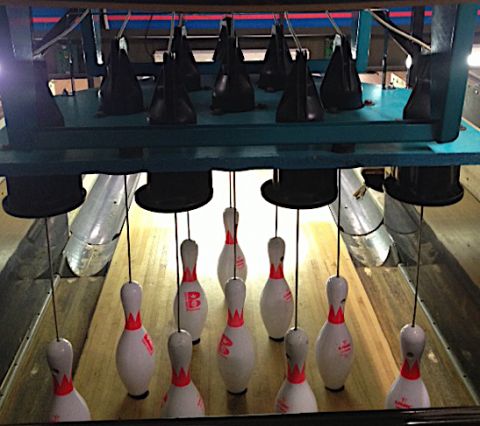
String pinsetters use regular bowling pins attached to cords that lift pins like marionettes and lower the unfallen pins back in place.
The U.S. Bowling Congress' research claims that string pins yield nearly 7% fewer strikes, more spares, and a lot more oddball splits than the old-style mechanical pinsetters. Of course, this doesn't make traditional league bowlers happy. Die-hard bowlers say this messes with their game. Casual bowlers aren't likely to notice or care.
The British Ten-pin Bowling Association began investigating string pinsetters in 2018. They found that league bowlers saw little difference in how sting pins fall. The International Bowling Federation has certified string pins for tournament play.
History of bowling
The first certified bowling alley in the United States is still in operation, unchanged, and located in the basement of the 115-year-old Holler House bar in Milwaukee, Wisconsin. Their two bowling lanes feature the original wood and are oiled with a spray can. Neighborhood kids reset the pins by hand, and the bowling shoes are in a jumble under the stairs. There's no room for seating and scores are kept by hand.
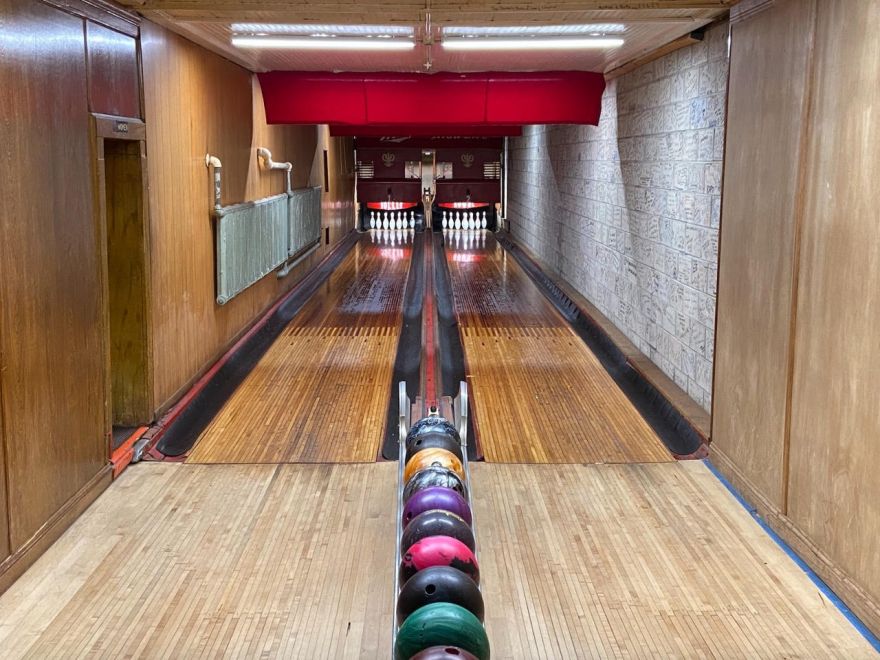
115-year-old Holler House bowling lanes
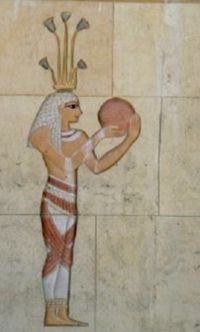
But he history of bowling dates back long before Holler House and ten-pin bowling. The earliest form of bowling can be traced back to ancient Egypt. Archaeologists found wall drawings depicting the game in an ancient royal tomb. In addition, a small set of pins and balls were found in an Egyptian child's grave that dates back to 3200 BC. This makes the first form of bowling over 5000 years old! In those days, balls were made from grain husks, covered in leather, and bound with string. Game historians believe Egyptians would have both rolled and thrown the balls at the pins. There are two basic forms of bowling - lawn bowling and pin-bowling. Egyptian bowling was believed to be a form of pin-bowling.
Lawn bowling's origins are obscure. The game, called 'lawn bowls' or 'bowls,' is played outside and is closely related to the Italian game bocci. Whatever the origin of the game, by 1299 it was a popular English pastime, often incorporating a bowling green into formal gardens. Lawn bowl is based on rolling the bowl towards a smaller ball called the jack. The game has many variations and is often played in teams. In its most basic form, the object of the game is to bowl as close as possible to the jack, which is bowled first. Modern lawn bowls are now played on a standardized court.
The simplicity and flexibility of the bowls made it a popular one, so popular that it was made illegal. In England in 1366, King Edward III allegedly outlawed bowling to keep his troops focused on archery practice. Henry VI reversed the ban in 1455. English legislation against bowling for all but the upper classes began during the reign of Henry VIII in 1511 and was strengthened in 1541. In 1618 King James issued the Declaration of Sports, which banned bowling on Sundays. The ban on bowling for all but nobility was not lifted until 1845.
Bowling as we know it in North America first started in Germany around 300 AD, where it was known as kegel spiel when German practitioners began knocking down their walking sticks. The church often called German citizens to prove that they were living an honorable life. To do so, the person's kegel was planted in the ground at the end of a runway, and the person would be asked to roll a reasonably round stone at the kegel. The kegel represented a temptation or sin, so players who could knock the kegel down were perceived as more righteous. The game evolved, and for many centuries the number of sticks or 'pins' used grew and varied in number. In the 1500s, Martin Luther decreed that 9 was the perfect number of pins to play. Over time, the kegel game changed from a test of one's religious faith and purity to a recreational game. The game '9 Pins' grew in popularity throughout Europe. To this day, Kegel is still popular in parts of Europe and is still played with nine pins in a diamond shape.
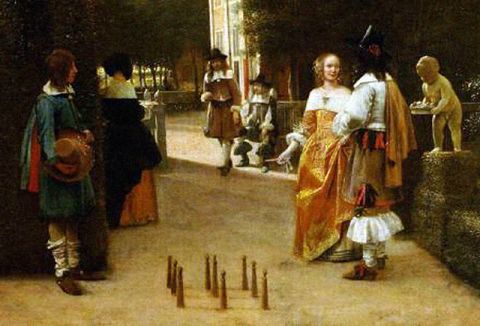
Skittles game from the detail of the painting "Skittle Players in a Garden" by Pieter de Hooch c. 1664
In the United Kingdom and Ireland, bowls evolved into a predecessor of nine-pin bowling called 'skittles' that came to America. Skittles is believed to come from the German kegel spiel. Skittles was typically played outside inns on smooth patches of ground. Skittles consisted of nine wooden pins and wooden balls. The balls were tossed at the pins to knock down as many as possible, and one point was earned per pin.
From time-to-time various improvements were made to skittles, such as providing a shelter over each end of the lane for the participants and spectators on one end and for the boy who stood by the frame to set up the pins when they were bowled down. The pin-boy called out the number of pins beaten down, which was credited to the bowler's score. Later a small trough was placed on one side of the lane with a gradual descent from the pins to the bowlers, the origin of the ball return and gutter.
Finally, it was decided to enclose the entire lane, so we have the origin of the indoor bowling lane, the first of which is understood to have been built in London in 1455 AD. In regions of the United Kingdom and Ireland, skittles remains a popular indoor pub game.
Bowling comes to America
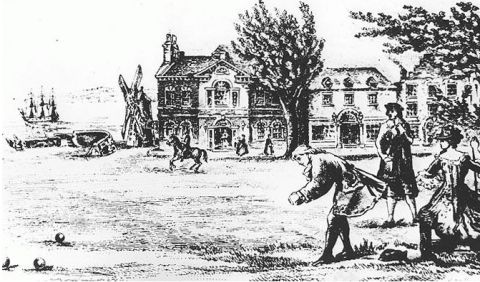
Bowling, in its various forms, made its way to America with the earliest English, Dutch, and German settlers. The first colonial reference to the game comes from Jamestown, Virginia. Sir Thomas Dale reported that as he came ashore at Jamestown to assume the governorship of the colony, he witnessed people playing bowls in the streets.
The first permanent American bowling location probably was for lawn bowling, in New York's Battery area by Dutchmen. Now the heart of the financial district, New Yorkers still call the small plot Bowling Green. This illustration by E. A. Abbey depicts Dutchmen bowling circa 1670 on Old King's Arms Tavern on land now at 2nd and Broadway in New York.
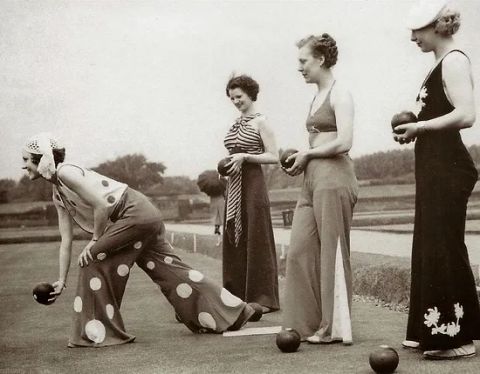
Women lawn bowling at the New York Bowling Club
While some sports, such as fishing and fowling, were considered safe by colonial America Puritan standards, ball sports, including bowls, were never an acceptable pastime because of their tendency to lead to gambling and loud and boisterous behavior among the players and spectators.
In 1994, archaeologists working in downtown Boston, Massachusetts recovered what turned out to be the oldest lawn bowling ball, commonly called a bowl, in the New World. It was found in a privy during the archeological investigations that preceded Boston's 'Big Dig' tunnel project. The lawn ball belonged to the household of Katherine Nanny Naylor, a wealthy resident of 17th-century Boston.
Birth of ten-pin bowling
Nine-pins was the most popular form of bowling in much of the United States from colonial times until the mid-19th century when nine-pins became illegal. In the early 19th century, bowling alleys were primarily owned by bars and pubs. A culture of crime and gambling became associated with bowling, and eventually, bowling gained a poor reputation. In 1841, Connecticut banned ownership of nine-pin lanes in an attempt to curb gambling and crime. That action was followed in many states until nine-pins was illegal everywhere in the U.S. Players simply added one more pin to get around the law, nullifying the ban, and the modern ten-pin game was born. For some reason, the legislatures of states permitted tenpins, and it grew. There have been few changes to the rules of the sport since then.
However, ten-pin bowling is not the only form of bowling in the U.S., and it is not the only form using string pinsetters.
Duckpin bowling
At one time, before the boom of league bowling in the later 1890s, ten-pin bowling was not as dominant as it is today. There are two other forms of bowling in America - duckpin and candlepin. Duckpin bowling uses a ball about the size of a grapefruit (4-3/4 to 5 inches in diameter) that weighs between 3 lb. 6 oz. to 3 lb.12 oz. and lacks the finger holes found on ten-pin balls. Compare that to ten-pin bowling balls which weigh up to 16 pounds and are 8.6 inches in diameter, with the lightest being a 6-pound ball that children generally use. Duckpins, arranged in a triangular pattern of 10 pins identical to ten-pin bowling, are shorter, smaller, and lighter than their ten-pin equivalents, about 2/3rds their size. Since duckpins don't score as high as ten-pins, there are three throws for each frame versus the two in ten-pin.
Duckpin bowling was born at the old Diamond Alleys, a bowling, billiards, and pool hall, in Baltimore, Maryland in the early 1890s. At the turn of the century, bowling leagues operated only during winter. In the summer, many centers closed down. However, a few centers, including Diamond Alleys, remained open for open play during the spring and summer. Diamond Alleys had some smaller six-inch balls that were used for such off-the-wall games as cocked-hat (using only the 1, 7, and 10 pins) and five back (using the 5, 7, 8, 9, and 10 pins). During one of these matches, someone suggested that a set of old, battered ten-pins could be made into little pins to conform to the six-inch ball. An old set was sent to a wood turner and the trimmed-down little pins were set up on the ten-pin spots, and the first unofficial "small ball" game was underway. Only two balls were used, as in ten-pins, and the score was kept similarly. One of the players, whose other hobby was duck hunting, saw the pins fly as the ball plowed into them, and he remarked that the pins looked like a "flock of flying ducks." A sportswriter for the Baltimore Morning Sun wrote a story on the fascinating new game and christened them "duckpins." The name has stuck ever since. Since duckpin bowling is far harder to score in than ten-pin, the game was later changed to three throws per frame. Still, no one has ever scored a perfect game of 300.
Automatic duckpin pinsetters were developed in 1953 by a kooky inventor named Kenneth Sherman and named the Sherman Pinsetter (video of Sherman duckpin setter). The pinsetters had over 1,000 moving parts. Before then, duckpins were set by hand by human pinsetters called pin boys. Duckpins suffered a critical blow when the Sherman company ceased operations in 1973. Brunswick Equipment offered to buy Sherman's patent, which would have kept the machinery in production, but he said no - a stroke of stubbornness duckpin bowlers call "The Curse of Ken Sherman."
So, after 1973 new pinsetters were no longer available to develop new duckpin centers. Existing operators were forced to cannibalize pinsetter parts off of pinsetters from closed bowling houses, often buying the machines and putting them into storage to use for spare parts. The lack of new pinsetters is a significant cause for the decline of duckpin bowling, as it thwarted the growth of new centers.
Candlepin bowling
The other form of bowling that is found in New England is candlepin bowling, first played in a local bowling center and billiards parlor in Worcester, Massachusetts in 1880. Justin White was credited with the concept. Throughout the 1880s, Justin worked to get the dimensions of both the balls and pins just right. Although candlepin bowling is essentially a variation of ten-pin, candlepin bowling was said to be invented years before the standardization of ten-pin bowling in 1895.
Candlepins are 15.75 inches tall, and have a cylindrical shape that tapers equally towards each end, and therefore having no distinct "top" or "bottom" end, unlike a ten-pin, giving them an overall appearance somewhat like that of a candle. The candlepin ball has a maximum weight of 2 lb. 7 oz., is without finger holes, and has a maximum diameter of 4½ inches, making it the smallest bowling ball of any type of North American bowling. Just like duckpin, the bowler gets three balls per frame. However, unlike ten-pin and duckpin, the downed pins (dead wood) are not cleared from the lane after each ball.
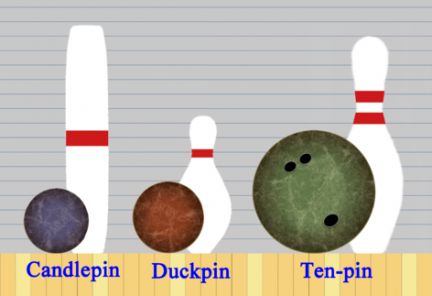 The three types of U.S. bowling |
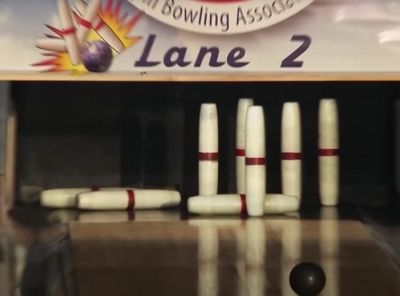 Candlepin bowling with dead wood on the lane. |
Automatic pinsetters
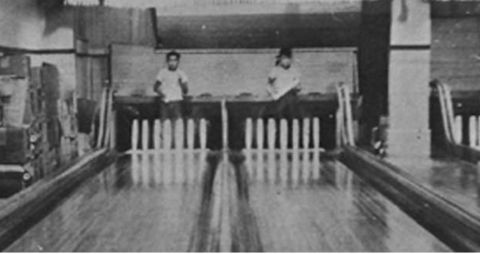
Pin boys at candlepin lanes
Until the invention of mechanical pinsetter machines, pins were reset by humans, pin spotters, also known as pin boys, typically teenage boys. Even the most experienced pin boys couldn't set the pins exactly the same each time. When finished setting the pins, they would jump up on a high bench in the back of the pins. Modern mechanical pinsetters solved the problem of exactly resetting the pins each time. The first pinsetter for ten-pins was invented in 1936, duckpins in 1953, and candlepins in 1956.
Open play
Until several decades ago, leagues dominated ten-pin bowling. Casual open-play bowling was only considered a secondary market and not given priority. The term 'open play' came about to describe when there were open (available) lanes that were not being used by leagues or tournaments. Leagues and tournaments had all the priority. Open play bowling was only available when sport bowlers didn't need the lanes. Typically, there were very few, if any open lanes during prime bowling times. Ten-pin bowling centers were initially designed and operated for sports leagues and competitive bowling, not the casual bowling public. The reason you still see older ten-pin centers with elevated concourses was so the sport's spectators had a good view. Years ago, some centers even had bleachers on the concourse.
String pinsetters came on the scene about a decade ago. What is driving older alleys to convert to them and new centers to install them is both cost savings and the fact that league bowling, once the bread and butter of bowling, has flip-flopped to where it's now the minority business for all but a few old league-focused alleys. Most new boutique, lounge, and hybrid bowling entertainment centers don't have leagues. And for the ones that do, the leagues are weekday social leagues and not really competitive. So, with league bowling no longer that essential and casual bowlers not caring what type pinsetter there is, center owners are choosing the most economical solution.
With the shift of bowling targeting casual social bowlers, there's been another change in bowling. The development of string pinsetters also allowed the reintroduction of duckpin bowling. Many new centers are installing duckpin rather than ten-pin bowling. Ten-pin bowling is not the friendliest form of bowling for casual players. The heavy ball with its three finger holes is awkward to throw and not user-friendly, especially for occasional bowlers and women and children. Over the years, ten-pin bowling has tried to make itself user-friendlier with lighter balls for children and women and bumper bowling, but it can still be very intimidating for many people.
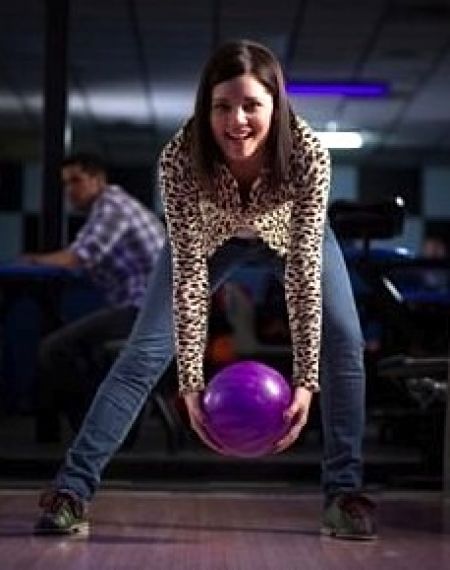 You must be kidding. Am I supposed to throw this ball down the lane? |
 Get real! This ball is almost as large as I am. |
Our company's research has found that much of the public sees the ten-pin bowling ball as a detriment to bowling. The large, heavy, three-finger-hole ball is intimidating. And that's the rub, or at least one of the barriers to increasing the number of people who casually bowl and how frequently they bowl.
Another advantage of duckpin bowling is that the lanes can be shortened from the regulation length required for sanctioned leagues. This allows the bowling to take up less space.
Our company was a pioneer in recognizing the competitive market advantage duckpin bowling had for new centers. In 2012 in our Leisure eNewsletter and later in a white paper, we wrote It's time to reinvent the game of bowling. Here are just a couple of extracts of what we wrote back then.
"We believe it is time to reinvent the game of bowling so it is user-friendly and a better fit for the type of experiences the new entertainment centers with bowling are seeking to offer. However, we don't really need to reinvent the game of bowling to do that. It's back to the future with duckpin bowling, the perfect fit for modern bowling with its small easy-to-handle ball and a game that is different enough that experienced ten-pin bowlers won't take it seriously. A game that is just fun for everyone...
"Bowling leagues, tournaments, and The Curse of Ken Sherman [the manufacture of automatic duckpin pinsetters who ceased operations in 1973] no longer stand in the way of developing new social-tainment and entertainment centers that feature bowling [with the new string pinsetters]. So, let's say goodbye to that 3-finger-hole heavy bowling ball type of bowling and let everyone discover how much more fun bowling can really be. It's back to the future with duckpins. Let the ducks fly!"
Since then, we have incorporated duckpin bowling in all the location-based entertainment centers we designed for our clients.

Centers designed & produced by White Hutchinson that incorporate duckpin bowling
Bowling is thousands of years old and continues to have strong appeal, especially since it is so well suited as a form of competitive socializing, also called socialized gaming, when it incorporates trendy, high-quality, foodie-worthy food, often in sharable portions, and curated beverage served at the lanes in contemporary and attractive atmospheres. Bowling has the perfect rhythm to facilitate social bonding, as one person plays while the others watch, chat, and enjoy their food and beverage-long live bowling in its new incarnation.
Vol. XXIII, No. 2, February 2023
- Editor's corner
- American bowling is in a knock-down fight over new high-tech pins
- Scrimp and splurge arrives
- Zillennials and their disposable income
- How large an industry is agritourism?
- Climatarian? Regenivore? New diets take aim at climate change
- What have at-home workers done with their saved commuting time?
- Pickleball growing faster than previously thought
- Anyone got the wakeup call?
- Americans demand businesses be value-driven
- An American pioneer in competitive socializing


